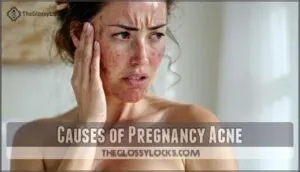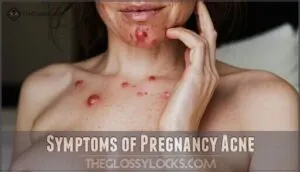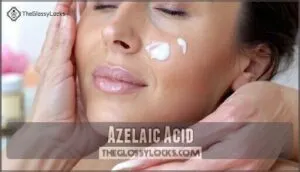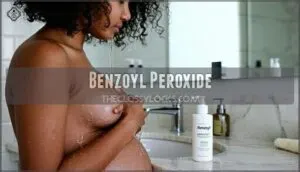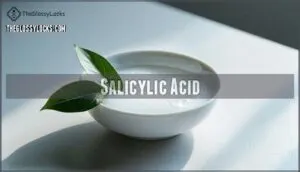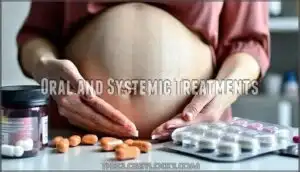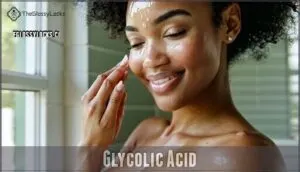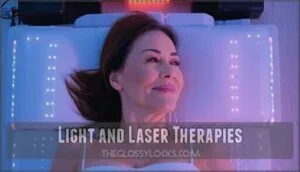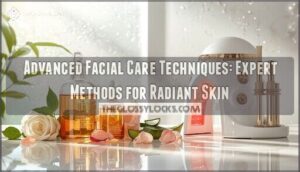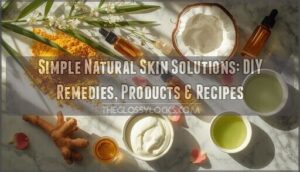This site is supported by our readers. We may earn a commission, at no cost to you, if you purchase through links.

Safe acne treatment during pregnancy focuses on gentle, proven ingredients that won’t harm your baby. You can confidently use azelaic acid, which reduces inflammation and unclogs pores, along with benzoyl peroxide in concentrations up to 5%.
Low-dose salicylic acid (under 2%) also gets the green light from dermatologists. However, you’ll need to shelve retinoids, high-strength acids, and oral medications that could cross the placental barrier.
Think of it as temporary skincare musical chairs, swapping harsh ingredients for gentler alternatives that still pack a punch against breakouts while keeping both you and baby safe.
Table Of Contents
- Key Takeaways
- Causes of Pregnancy Acne
- Symptoms of Pregnancy Acne
- Safe Topical Treatments
- 5 Best Pregnancy Acne Treatments
- Oral and Systemic Treatments
- Alternative Acne Treatments
- Frequently Asked Questions (FAQs)
- Can acne be treated in pregnancy?
- What are the best pregnancy-safe acne treatments?
- Can pregnancy-related acne be treated safely?
- Can I take acne medication while pregnant?
- Can I use OTC acne treatments during pregnancy?
- How many pregnancy-safe acne treatments are there?
- What can you use for acne while pregnant?
- What is the best face cleanser for pregnancy acne?
- When does pregnancy acne typically resolve postpartum?
- Can hormonal birth control worsen pregnancy acne?
- Conclusion
Key Takeaways
- You can safely use azelaic acid, benzoyl peroxide (up to 5%), and low-dose salicylic acid (under 2%) to treat pregnancy acne without harming your baby.
- You must avoid retinoids, high-strength acids, and oral medications like isotretinoin during pregnancy as they can cause serious birth defects.
- You’ll likely see pregnancy acne develop due to increased androgen levels and hormonal changes, typically appearing as inflamed bumps on your face, chest, and back.
- You should expect pregnancy acne to resolve within three to six months postpartum as your hormone levels stabilize, though consistency with gentle treatments matters more than strength.
Causes of Pregnancy Acne
If you’re wondering why your skin decided to throw a rebellion party during pregnancy, you can blame your hormones for the uninvited breakouts.
Your skin’s hormonal rebellion during pregnancy isn’t personal—it’s just biology throwing the ultimate tantrum.
Your body’s increased androgen levels, combined with pregnancy-related immune changes, create the perfect storm for acne by ramping up oil production and inflammation in your pores.
Hormonal Changes During Pregnancy
Pregnancy turns your body into a hormone factory, triggering significant skin changes during pregnancy that can catch you off guard.
These pregnancy hormones create the perfect storm for pregnancy acne and hormonal acne pregnancy issues.
Your body experiences major shifts that affect pregnancy skincare needs:
- Progesterone Levels skyrocket, increasing sebum production
- Estrogen Influence fluctuates throughout trimesters
- Skin Sensitivity heightens due to hormonal fluctuations
Increased Androgen Concentrations
When your body ramps up androgen production during pregnancy, it’s like adding fuel to the acne fire.
These hormones trigger increased sebum production and follicular hyperkeratinization, creating the perfect storm for breakouts.
Understanding these androgen effects helps explain why your pregnancy acne treatment needs differ from your usual skincare routine.
| Androgen Effect | Skin Impact | Acne Severity Result |
|---|---|---|
| Increased Testosterone | Higher sebum production | Mild to moderate breakouts |
| Elevated DHT Levels | Enlarged pore formation | Comedone development |
| Progesterone Surge | Follicular hyperkeratinization | Clogged pores, blackheads |
| Hormonal Fluctuation | Enhanced inflammation cascade | Papules and pustules |
| Peak Third Trimester | Maximum oil gland activity | Severe cystic acne |
Pregnancy-associated Immunologic Factors
Beyond hormonal shifts, your immune system undergoes significant changes during pregnancy that can trigger acne flares.
These immunologic factors alter your skin barrier function and increase inflammatory cytokines, creating perfect conditions for breakouts.
Your body’s microbiome influence shifts too, affecting how your skin responds to bacteria.
Understanding these autoimmunity impacts helps explain why safe acne treatment becomes essential during pregnancy.
Symptoms of Pregnancy Acne
You’ll typically notice pregnancy acne appearing as red, inflamed bumps on your face, chest, and back, often more severe than the blackheads and whiteheads you might remember from your teenage years.
These breakouts commonly show up around your chin and jawline first, though they can spread to your neck and other areas as hormonal changes increase oil production throughout your pregnancy.
Inflammatory Lesions
Most pregnancy acne manifests as inflammatory lesions—those angry, red bumps that make you want to hide behind oversized sunglasses.
These painful pimples often spread beyond your face to involve your trunk, thanks to your body’s heightened immunologic response.
The lesion severity can vary dramatically, and unfortunately, this inflammatory acne may persist as postpartum acne, especially if dietary impact worsens symptoms.
Noninflammatory Lesions
Noninflammatory lesions, like whiteheads and blackheads, result from clogged pores called comedones.
These mild acne symptoms are common during pregnancy, thanks to your hormones working overtime.
While they’re less dramatic than inflammatory breakouts, they’re still tricky.
Stick to pregnancysafe skincare options, like gentle cleansers and moisturizers crafted for acne during pregnancy.
Look for pregnancysafe acne treatments to keep your glow intact.
Acne on The Face, Chest, and Back
Three common areas where pregnancy acne strikes hardest are your face, chest, and back.
These breakouts often feel more intense than typical acne, with increased skin sensitivity making treatment tricky.
The severity factors vary by trimester, but don’t worry—safe acne treatment options exist for each location.
Early scarring prevention helps maintain your confidence during this transformative time.
Safe Topical Treatments
When you’re dealing with pregnancy acne, topical treatments offer a safer alternative to oral medications since they’ve minimal absorption into your bloodstream.
You’ll find several effective options that dermatologists recommend during pregnancy, including azelaic acid, benzoyl peroxide, and carefully selected concentrations of salicylic acid.
Azelaic Acid
Azelaic acid stands out as your pregnancy’s skincare ally, offering a gentle yet effective approach to stubborn breakouts.
This naturally occurring compound works by unclogging pores, reducing inflammation, and fighting acne-causing bacteria without the harsh side effects you’d expect from stronger treatments.
- Azelaic Benefits: Provides antimicrobial and anti-inflammatory properties with minimal systemic absorption
- Acid Mechanism: Unclogs pores while reducing redness and bacterial growth safely
- Application Tips: Start with lower concentrations, apply thin layers twice daily after cleansing
- Side Effects: May cause mild irritation, tingling, or dryness during initial use
This topical azelaic acid treatment offers safe acne treatment during pregnancy, making it an ideal pregnancy-safe acne treatment option for managing acne during pregnancy effectively.
Benzoyl Peroxide
When dealing with stubborn pregnancy acne, benzoyl peroxide stands out as your reliable ally.
This topical therapy boasts impressive BP effectiveness against acne-causing bacteria, with studies showing 5% systemic absorption during pregnancy acne treatment.
Start with lower BP concentration (2.5-4%) to minimize BP side effects like dryness.
Consider product options here if you’re unsure where to start.
Unlike antibiotics, BP resistance doesn’t develop, making it a consistently safe acne treatment option throughout your pregnancy journey.
Salicylic Acid
While benzoyl peroxide targets bacteria, salicylic acid takes a different approach to pregnancy acne treatment.
This beta hydroxy acid excels at unclogging pores through gentle exfoliation, but requires careful consideration during pregnancy.
Salicylic Acid Safety Guidelines:
- Low concentrations (2% or less) are pregnancy-safe for topical use
- Avoid chemical peels due to increased dermal penetration risks
- Limit use to prevent excessive absorption
- Always consult your healthcare provider first
5 Best Pregnancy Acne Treatments
You’re dealing with pregnancy acne, and while your skincare routine needs adjustment, you don’t have to suffer through breakouts for nine months.
These five dermatologist-recommended products contain pregnancy-safe ingredients that effectively target acne without compromising your baby’s health.
1. CeraVe Acne Foaming Cream Cleanser
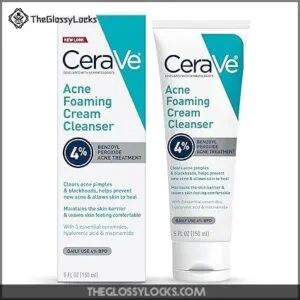
CeraVe’s gentle-yet-effective cleanser transforms from cream to foam, making it perfect for pregnancy acne management.
You’ll appreciate its 4% benzoyl peroxide formula that clears breakouts without stripping your skin’s natural moisture barrier.
The addition of hyaluronic acid, niacinamide, and ceramides helps maintain hydration while calming irritated skin.
Since it’s fragrance-free and non-comedogenic, you won’t worry about pore-clogging ingredients.
This dermatologist-developed cleanser works well for sensitive skin, though you’ll want to follow up with a good moisturizer to prevent any dryness.
Best For: Individuals with acne-prone and sensitive skin, including those managing pregnancy acne.
- Contains 4% benzoyl peroxide to effectively treat breakouts.
- Includes hydrating ingredients like hyaluronic acid and soothing niacinamide.
- Fragrance-free, non-comedogenic, and developed by dermatologists.
- Can cause dryness, requiring a moisturizer afterward.
- May bleach towels and clothing.
- Less foamy texture than some users expect.
2. PanOxyl 4% Benzoyl Peroxide Acne Wash
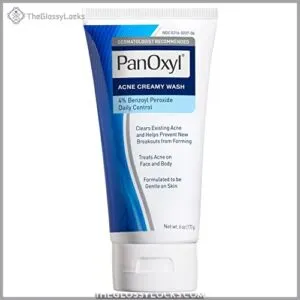
When you need heavy-duty acne fighting power, PanOxyl’s 4% Benzoyl Peroxide Acne Wash delivers results that many pregnant women swear by.
This dermatologist-recommended cleanser kills acne-causing bacteria while gently unclogging pores on your face, chest, and back.
Its pH-balanced formula includes four humectants and three emollients, so you won’t feel like sandpaper afterward.
The gentle 4% concentration makes it perfect for daily use, though you’ll want to start with white towels since benzoyl peroxide can bleach fabrics.
Best For: Individuals with mild to moderate acne seeking a dermatologist-recommended, gentle daily cleanser.
- Contains 4% Benzoyl Peroxide for effective bacteria-fighting and pore-unclogging.
- PH-balanced formula with humectants and emollients for added hydration and skin comfort.
- Suitable for daily use and sensitive skin when patch-tested.
- May cause dryness or irritation, requiring cautious use or gradual introduction.
- Can bleach fabrics, necessitating the use of white towels.
- Not suitable for all skin types, particularly combination or highly sensitive skin.
3. Olay Niacinamide Peptide Firming Moisturizer
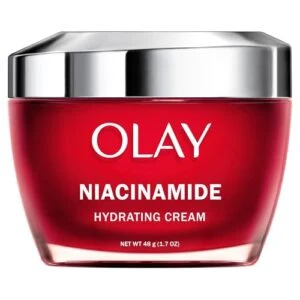
With pregnancy hormones wreaking havoc on your skin, you’ll want a gentle moisturizer that won’t add fuel to the fire.
Olay Niacinamide Peptide Firming Moisturizer contains 99% pure niacinamide, which helps regulate oil production and reduces inflammation without harsh side effects.
The peptides strengthen your skin barrier while providing 24-hour hydration.
Since it’s free from parabens and synthetic dyes, you can use it twice daily without worry.
It’s like having a skincare safety net during those unpredictable pregnancy months.
Best For: Those looking for a gentle, effective moisturizer that hydrates, strengthens the skin barrier, and is safe for use during pregnancy.
- Contains 99% pure niacinamide and peptides for enhanced hydration.
- Free from parabens, phthalates, and synthetic dyes, making it safe for sensitive skin.
- Provides visible improvements in skin texture and firmness within a week.
- May have absorption issues for some users over time.
- Light fragrance might not suit those sensitive to scents.
- Results may vary for users with advanced wrinkles or severe skin concerns.
4. Cetaphil Pro Oil Removing Wash
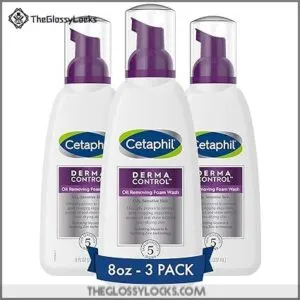
Fourth on our list, Cetaphil Pro Oil Removing Wash tackles excess sebum production head-on during pregnancy.
This clinically proven formula removes 99% of excess oil, makeup, and pore-clogging impurities without overdrying your sensitive skin.
The gentle foaming action contains hydrating glycerin and soothing zinc technology, making it perfect for combination or oily pregnancy skin.
You’ll love how it leaves your complexion feeling clean and matte, ready for your next skincare step without that tight, stripped feeling.
Best For: Individuals with oily or combination skin, particularly during pregnancy, seeking a gentle yet effective oil-removing cleanser.
- Removes 99% of excess oil and impurities without overdrying.
- Contains hydrating glycerin and soothing zinc technology.
- Leaves skin feeling clean, matte, and ready for skincare.
- May not be as effective at removing heavy makeup.
- Limited focus on hydration for dry skin types.
- Pump dispenser may not be travel-friendly.
5. Dr Brandt Microdermabrasion Face Exfoliator
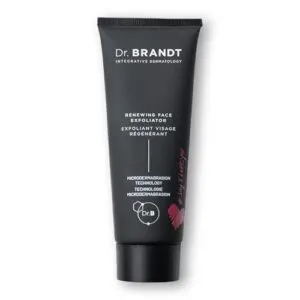
While gentle exfoliation can help manage pregnancy acne, you’ll want to proceed cautiously with the Dr Brandt Microdermabrasion Face Exfoliator.
This product combines physical microgranules with chemical exfoliants like glycolic and lactic acids to resurface skin and reduce acne scars. Though the manufacturer states it’s safe during pregnancy, the dual-action formula might be too intense for your already-sensitive pregnancy skin.
Start with once weekly use if you choose to try it, and discontinue if irritation occurs. Gentler alternatives may suit you better.
Best For: People looking to reduce dull skin, uneven texture, fine lines, and acne scars with a dual-action formula that combines physical and chemical exfoliation.
- Combines physical and chemical exfoliation for effective results.
- Safe for sensitive skin and suitable for all skin types.
- Inspired by professional microdermabrasion treatments.
- May be too intense for highly sensitive or pregnancy skin.
- Requires careful use to avoid over-exfoliation or irritation.
- Not ideal for those who prefer a scent or fragrance in skincare.
Oral and Systemic Treatments
When topical treatments aren’t enough to control your pregnancy acne, you’ll need to examine oral and systemic options with extra caution, since these medications enter your bloodstream and can potentially affect your developing baby.
Your healthcare provider will carefully weigh the benefits against potential risks, recommending only pregnancy-safe antibiotics like erythromycin or cephalexin for moderate to severe cases, while strictly avoiding certain medications that could harm fetal development.
Oral Antibiotics
When topical treatments aren’t cutting it, oral antibiotics become your next line of defense against stubborn pregnancy acne.
These medications require careful consideration since they enter your bloodstream and can potentially affect your developing baby.
Safe options for pregnancy acne treatment include:
- Erythromycin Safety – Generally safe during second and third trimesters, though avoid the estolate form
- Cephalosporin Use – First-line choice with excellent fetal safety profiles throughout pregnancy
- Azithromycin Risks – Usually safe but rare birth defect cases reported
- Alternative Options – Penicillin and amoxicillin offer additional safe acne treatment choices
Always combine oral antibiotics with benzoyl peroxide to prevent Resistance Concerns and maximize effectiveness.
Oral Corticosteroids
For severe nodular acne that won’t budge, oral corticosteroids like prednisone might come into play.
However, doctors approach this treatment with extreme caution during pregnancy. You’ll typically avoid these medications during the first trimester due to teratogenicity concerns.
If prescribed later, expect strict dosage concerns and limited treatment duration to minimize side effects.
Contraindicated Medications
Certain medications pose serious risks during pregnancy and must be avoided.
Oral isotretinoin and topical retinoids can cause severe birth defects, while tetracyclines affect fetal bone and tooth development.
Sulfamethoxazole concerns include miscarriage risks, and spironolone may feminize male fetuses.
These retinoid dangers and tetracycline risks make alternative pregnancy acne treatments essential for your baby’s safety.
Alternative Acne Treatments
When traditional topical treatments aren’t enough, you’ve got several alternative options that can safely tackle stubborn pregnancy acne.
These evidence-based approaches, including zinc supplements, gentle chemical peels, and specialized light therapies, offer promising results without the risks associated with stronger medications during pregnancy.
The use of these methods provides a safer alternative for managing pregnancy acne.
Zinc
Beyond topical treatments, zinc offers promising benefits for pregnancy acne through its antibacterial and anti-inflammatory properties.
You’ll find zinc forms like zinc sulfate or zinc gluconate helpful for mild to moderate breakouts.
While dietary zinc from foods supports skin health, supplement dosage should be discussed with your healthcare provider.
Consider supplement options during pregnancy after consulting your doctor.
Watch for zinc side-effects like nausea when considering this pregnancy-safe skincare option that utilizes zinc properties.
Glycolic Acid
Glycolic acid gently breaks down dead skin cells, making it a standout choice for pregnancy acne treatment.
This alpha-hydroxy acid offers significant glycolic acid benefits without harsh side effects.
You’ll want to start with lower peel concentrations due to increased skin sensitivity during pregnancy.
Consider product options available for sensitive skin.
Many pregnancy-safe skincare lines offer gentle home peels, though professional product recommendations guarantee maximal safety for expectant mothers.
Photodynamic Therapy
Photodynamic therapy combines aminolevulinic acid (ALA) with specific light sources for acne treatment.
While ALA effectiveness shows promise in non-pregnant patients, this pregnancy acne treatment lacks sufficient safety data during pregnancy.
Treatment sessions typically require multiple visits, and insurance coverage remains limited.
Given the potential risks to fetal development, safe acne treatment alternatives are recommended over photodynamic therapy during pregnancy.
Light and Laser Therapies
Light therapy and laser treatments offer promising pregnancy safe acne treatment options when photodynamic therapy isn’t suitable.
Blue-red light therapy combines 415nm and 650nm wavelengths, effectively reducing inflammatory lesions with superior treatment efficacy compared to single-wavelength approaches.
Nd:YAG and pulsed-dye lasers show excellent laser safety profiles during pregnancy, though procedure side effects like temporary redness may occur.
These treatments provide encouraging long-term results for expectant mothers, making them a viable option for those seeking effective acne treatment during pregnancy.
Frequently Asked Questions (FAQs)
Can acne be treated in pregnancy?
Like traversing a minefield, treating acne during pregnancy requires careful steps.
You can safely use azelaic acid, benzoyl peroxide, and topical antibiotics.
However, you’ll need to avoid retinoids and tetracyclines completely.
What are the best pregnancy-safe acne treatments?
Azelaic acid and benzoyl peroxide are your safest bets for treating pregnancy acne.
You can also use topical antibiotics like clindamycin or erythromycin.
Always consult your dermatologist before starting any treatment plan.
Can pregnancy-related acne be treated safely?
Yes, you can safely treat pregnancy-related acne with specific options.
Topical azelaic acid, benzoyl peroxide, and certain antibiotics like clindamycin work effectively.
Always consult your healthcare provider before starting any treatment regimen.
Can I take acne medication while pregnant?
Taking acne medication during pregnancy requires careful consideration.
Some topical treatments like azelaic acid and benzoyl peroxide are safe, but oral medications like isotretinoin are dangerous.
Always consult your doctor first.
Can I use OTC acne treatments during pregnancy?
Over-the-counter acne treatments can be tricky during pregnancy.
You’ll want to stick with benzoyl peroxide and azelaic acid, which are generally safe.
However, avoid salicylic acid products and always check with your doctor first.
How many pregnancy-safe acne treatments are there?
Good things come to those who wait, but you don’t have to wait long for safe options.
You’ve got several pregnancy-safe acne treatments available, including azelaic acid, benzoyl peroxide, and topical antibiotics like clindamycin.
What can you use for acne while pregnant?
You can safely use azelaic acid, benzoyl peroxide (low concentrations), topical antibiotics like clindamycin, and gentle exfoliants such as glycolic acid.
Always consult your doctor before starting any acne treatment during pregnancy.
What is the best face cleanser for pregnancy acne?
Like a medieval apothecary would suggest gentle herbs, you’ll want mild, fragrance-free cleansers with salicylic acid or glycolic acid.
Avoid harsh scrubs that irritate sensitive pregnancy skin—think CeraVe Foaming Facial Cleanser or Neutrogena Ultra Gentle.
When does pregnancy acne typically resolve postpartum?
Pregnancy acne typically resolves within three to six months postpartum as your hormone levels stabilize. However, if you were acne-prone before pregnancy, breakouts might persist longer and require continued treatment.
Can hormonal birth control worsen pregnancy acne?
Surprisingly, 30% of women experience acne flares when starting birth control.
You can’t use hormonal contraceptives during pregnancy, but pre-pregnancy hormonal changes from birth control may influence your skin’s sensitivity to pregnancy hormones.
Conclusion
Research shows that up to 50% of pregnant women experience acne flare-ups, making safe acne treatment during pregnancy a common concern.
You’ve now got five dermatologist-approved options that effectively target breakouts without compromising your baby’s safety.
Remember, consistency matters more than strength when managing pregnancy acne. Stick with gentle ingredients like azelaic acid and low-dose benzoyl peroxide, avoid retinoids completely, and don’t hesitate to consult your dermatologist for personalized guidance throughout your skincare journey.
- https://links.e.response.mayoclinic.org/EmailPreview-GeneralHealth
- https://mcforms.mayo.edu/mc5200-mc5299/mc5256-01.pdf
- https://www.acog.org/womens-health/faqs/skin-conditions-during-pregnancy
- http://www.ncbi.nlm.nih.gov/pubmed/23657872
- https://www.dermpartners.com/medical-staff/medical-doctors/423-kate-victoria-viola-md-mhs-faad

